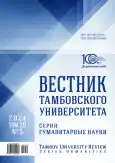Erratological model of teaching Russian to foreign non-philologist
- Authors: Tskhovrebov A.S.1
-
Affiliations:
- St. Petersburg State University
- Issue: Vol 29, No 5 (2024)
- Pages: 1337-1352
- Section: THEORY AND METHODS OF TEACHING RUSSIAN AS A FOREIGN LANGUAGE
- URL: https://journal-vniispk.ru/1810-0201/article/view/297668
- DOI: https://doi.org/10.20310/1810-0201-2024-29-5-1337-1352
- ID: 297668
Cite item
Full Text
Abstract
Importance. In the modern world, there is a continuous search for new approaches to teaching students the Russian language. This problem is especially relevant when it comes to foreign stu dents of technical universities who must not only get a profession in Russian but also successfully adapt to Russian society. The purpose of the study is to develop an authorial (erratological) model of teaching the Russian language to non-philological foreigners. Its structural and meaningful de scription is proposed.Materials and methods. The base for the experimental research is the Military Institute (engineer ing and technical) of the Military Academy of Logistics and Technical Support named after. Army General A.V. Khruleva. The research material is based on a corpus of errors identified in the proc ess of analysing the non-philology students’ speech. The key research method is the error analysis method.Results and Discussion. The research result is the development of an erratological teaching model based on a nine-stage error analysis system, which includes recognition of erroneous activity – re cording the fact of deviation – identification of errors – formulation of grammatical rules instructions – correction (elimination) of errors – control and correction activities (training) – for mation self-control skills – fixation of error-free (correct) speech activity – reflection of acquired knowledge.Conclusion. The results obtained suggest that the use of the author’s conceptual model of peda gogical influence in classes for a foreign audience will not only develop Russian-speaking profes sional competence but also ensure the undoubted foreign student’s interest in learning a new lan guage and will also contribute to the intensification of the educational process, enriching it with new technologies, teaching methods, and a new system of tasks.
About the authors
A. S. Tskhovrebov
St. Petersburg State University
Author for correspondence.
Email: alanec1985@mail.ru
ORCID iD: 0000-0002-5199-1460
Cand. Sci. (Education), Associate Professor of Russian as a Foreign Language and Methods of Teaching It Department
7/9 Universitetskaya Emb., St. Petersburg, 199034, Russian FederationReferences
- Brillyuehn L. (1966). Nauchnaya neopredelennost’ i informatsiya. Moscow, Mir Publ., 272 p. (In Russ.) https://elibrary.ru/qjpylt
- Kepler J. (1966). The six-cornered snowflake. Oxford, Clarendon Press, 150 p.
- Corder S.P. (1984). The significance of learners’ errors. Error Analysis, vol. 5, no. 4, pp. 161-169.
- Richards J. (1970). A non-contrastive approach to error analysis. Paper given at the TESOL convention. San-Francisco.
- Laleko O. (2018). What is difficult about grammatical gender? Evidence from Heritage Russian. Journal of Language Contact, no. 11 (2), pp. 233-267.
- Lemmerth N., Hopp H. (2019). Gender processing in simultaneous and successive bilingual children. Cross-Linguistic Lexical and Syntactic Influences. Language Acquisition, vol. 26, no. 1, pp. 21-45.
- Laleko O., Dubinina I. (2018). Word order production in heritage Russian: Perspectives from linguistics and pedagogy. Connecting Across Languages and Cultures: A Heritage Language. Festschrift in Honor of Olga Kagan. Bloomington, Slavica Publ., pp. 191-215.
- Kourovskii A.V. (2013). The erratologic aspect of the translation of zoonyms from english into Russian (data: scientific biological texts). Vestnik Tomskogo gosudarstvennogo pedagogicheskogo universiteta = Tomsk State Pedagogical University Bulletin, no. 10 (138), pp. 148-152. (In Russ.) https://elibrary.ru/rsxont
- Luttseva M.V. (2014). Role of erratology in the development of economics student’s language competence. Perevod i Sopostavitel’naya Lingvistika, no. 10, pp. 25-29. (In Russ.) https://elibrary.ru/stdbzx
- Kakzanova E.M. (2014). Erratology in translation of a science text. Perevod i sopostavitel’naya lingvistika, no 10, pp. 21-24. (In Russ.) https://elibrary.ru/stdbzn
- Shchelokova A.A. (2020). Erratology as general theory of errors. Sotsio- i psikholingvisticheskie issledovaniya, no. 8, pp. 168-172. (In Russ.) https://elibrary.ru/stccvn
- Koval’chuk E.A. (2015). A systemic quantitative approach to the translation quality assessment. Drevnyaya i Novaya Romaniya, no. 16, pp. 507-523. (In Russ.) https://elibrary.ru/vogjbn
- Gu Tszyun’lin, Khuan Chzhunlyan’ (2016). Study into classifications of translation mistakes. Vestnik Moskovskogo universiteta. Ser. 22. Teoriya perevoda = Moscow University Translation Studies Bulletin, no. 3, pp. 26-40. (In Russ.) https://elibrary.ru/xsuacb
- Iskandari M. (2023). Erratological aspect of translation from Persian into Russian at the middle stage of teaching the Russian language to Persian-speaking students. Vestnik Moskovskogo gosudarstvennogo oblastnogo universiteta. Seriya: Pedagogika = Bulletin of Moscow Region State University. Series: Peda-gogics, no. 2, pp. 102-110. https://doi.org/10.18384/2310-7219-2023-2-102-110, https://elibrary.ru/jsfykj
- Krasnopeeva E.S. (2015). On the place of translation universals concept in translated discourse research. Vestnik Chelyabinskogo gosudarstvennogo universiteta = Bulletin of Chelyabinsk State University, no. 27 (382), pp. 108-113. (In Russ.) https://elibrary.ru/vmbemj
- Pushkina A.V. (2013). Error analysis in the process of interpretation training. Vestnik RUDN. Seriya «Voprosy obrazovaniya: yazyki i spetsial’nost’» = RUDN Journal of Language Education and Translingual Practices, no. 2, pp. 73-75. (In Russ.) https://elibrary.ru/qbwsmp
- Shevnin A.B. (2004). Erratology and interlingual communication. Vestnik VGU. Seriya «Lingvistika i mezhkul’turnaya kommunikatsiya» = Proceedings of Voronezh State University. Series: Linguistics and Intercultural Communication, no. 2, pp. 36-44. (In Russ.) https://elibrary.ru/pjdjwl
- Yakovlev A.A. (2010). K voprosu ob ehrratologii v perevode. Lingua Mobilis, no. 5 (24), pp. 111-116. (In Russ.) https://elibrary.ru/mszkjz
- Tskhovrebov A.S. (2024). Theory and methods of teaching Russian as a foreign language. Vestnik Tam-bovskogo universiteta. Seriya: Gumanitarnye nauki = Tambov University Review. Series: Humanities, vol. 29, no. 3, pp. 709-722. (In Russ.) https://doi.org/10.20310/1810-0201-2024-29-3-708-723, https://elibrary.ru/lujimu
- Kovrizhkina D.G., Moskovkin L.V. (2023). Lexical features of Russian speech of bilinguals in Germany and monolinguals in Russia: an experimental study. Rusistika = Russian Language Studies, vol. 21, no. 3, pp. 278-292. (In Russ.) https://elibrary.ru/sqrqsw
- Tskhovrebov A.S., Shamonina G.N. (2023). Syntactic features of Russian speech of two generations of bilinguals and monolinguals: a complex sentence. Rusistika = Russian Language Studies, vol. 21, no. 3, pp. 293-305. (In Russ.) https://elibrary.ru/sxvyoh
- Magomedova T.I. (2009). Russkoyazychnaya professional’naya kommunikativnaya kompetentsiya studentov yuridicheskogo profilya: model’ i tekhnologiya formirovaniya v usloviyakh poliyazychiya. Makhachkala, DGU Publ., 232 p. (In Russ.) https://elibrary.ru/quibyz
Supplementary files









